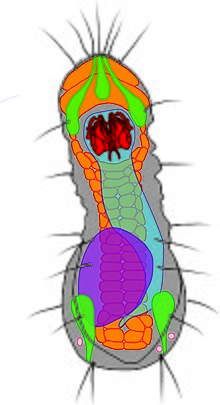Limnognathia
| Limnognathia | |
|---|---|

| |
| Schematic drawing ofLimnognathia maerski | |

| |
| Microscopic onL. maerski | |
| Scientific classification | |
| Domain: | Eukaryota |
| Kingdom: | Animalia |
| Subkingdom: | Eumetazoa |
| Clade: | ParaHoxozoa |
| Clade: | Bilateria |
| Clade: | Nephrozoa |
| (unranked): | Protostomia |
| (unranked): | Spiralia |
| Clade: | Gnathifera |
| Phylum: | Micrognathozoa |
| Order: | Limnognathida |
| Family: | Limnognathiidae |
| Genus: | Limnognathia |
| Species: | L. maerski
|
| Binomial name | |
| Limnognathia maerski Kristensen&Funch,2000
| |
Limnognathia maerskiis a microscopicacoelomatefreshwater animal, discovered living in coldspringsonDisko Island,Greenland,in 1994.[1]Since then, it has also been found on theCrozet IslandsofAntarctica[2]as well as in the British Isles,[3]suggesting a worldwide distribution, although there are likely different species yet to be described.
With an average length of 100micrometers(μm), it is one of the smallest known animals.
Etymology of Micrognathozoa: From the GreekMicros(= very small)Gnathos(= jaw) andZoon(= animal)
L. maerskiis theonly speciesthat belongs to the Micrognathozoa, a relatively new phylum of animals that was only described in 2000. [4][5]
Description
[edit]Feeding
[edit]L. maerskimainly feeds on bacteria, blue-green algae, anddiatoms.It has very complex jaws, with fifteen separate elements; these elements are very small, ranging from 4μmto 14 μm. The animal can extend part of its jaw structure outside its mouth while eating. It also extends much of its jaw structure outside its mouth when it is regurgitating indigestible items.
Anatomy
[edit]L. maerskihas a largeganglion,or 'brain', in its head, and paired nerve cords extending ventrally (along the lower side of the body) towards the tail. Stiff sensory bristles made up of one to threeciliaare scattered about the body. These bristles are similar to ones found ongnathostomulids,but up to three cilia may arise from a single cell inL. maerski,while gnathostomulids never have more than one cilium per cell.
Flexible cilia are arranged in a horseshoe-shaped area on the forehead, and in spots on the sides of the head and in two rows on the underside of the body. The cilia on the forehead create a current that moves food particles towards the mouth. The other cilia move the animal.
Reproduction
[edit]All specimens ofL. maerskithat have been collected have hadfemale organs.They lay two kinds of eggs: thin-walled eggs that hatch quickly, and thick-walled eggs that are believed to be resistant to freezing, and thus capable of over-wintering and hatching in the spring. The same pattern is known fromrotifers,where thick-walled eggs only form after fertilization by males. The youngestL. maerskispecimens collected may also havemale organs,and it is now theorized that the animals hatch as males and then become females (sequential hermaphroditism).
Taxonomy and phylogeny
[edit]Taxonomic status
[edit]Limnognathia maerskiis nominally aplatyzoan,but has variously been assigned as aclassorsubphylumin the cladeGnathiferaor as a phylum in a Gnathiferasuperphylum,namedMicrognathozoa.It is related to therotifersandgnathostomulids,grouped together as the Gnathifera.[6][7]
Phylogeny
[edit]Cladogram[8]showing the relationships ofLimnognathia:
| Gnathifera |
| ||||||||||||
TheGnathiferais the sister group to therest of the spiraliansand is crucial to understand because of its relationship toanimalevolution.
References
[edit]- ^Gastrotricha and Gnathifera
- ^de Smet, W.H. (2002). "A new record ofLimnognathia maerski[Kristensen & Funch, 2000](Micrognathozoa) from the subantarctic Crozet Islands, with redescription of the trophi ".Journal of Zoology.258:381–393.doi:10.1017/S095283690200153X.
- ^Worsaae and Kristensen, 2016
- ^Nielsen and Claus, 2013:Nielsen, Claus, 'Phylum Micrognathozoa', Animal Evolution: Interrelationships of the Living Phyla, 3rd edn (Oxford, 2011; online edn, Oxford Academic, 17 Dec. 2013),https://doi.org/10.1093/acprof:oso/9780199606023.003.0033,accessed 28 Jan. 2024./
- ^https://earthlife.net/micrognathozoa
- ^Kristensen, R.M.(July 2002)."An Introduction to Loricifera, Cycliophora, and Micrognathozoa".Integr Comp Biol.42(3): 641–51.doi:10.1093/icb/42.3.641.PMID21708760.
- ^Gordon, Dennis P. (2009). "Towards a management hierarchy (classification) for theCatalogue of Life".In Bisby, F.A.; Roskov, Y.R.; Orrell, T.M.; Nicolson, D.; et al. (eds.).Species 2000 & ITIS Catalogue of Life(Draft discussion document). 2009 Annual Checklist. Reading, UK: Species 2000. Archived fromthe original(CD-ROM)on 8 August 2009.
- ^"Phylogeny".zmuc.dk.14 December 2005. Archived fromthe originalon 24 December 2018.Retrieved3 March2018.
External links
[edit]- "Limnognathiaintroduction ".zmuc.dk.Københavns Universitet (University of Copenhagen). Archived fromthe originalon 2 December 2019.Retrieved10 December2021.— Comprehensive information onL. maerski
- "Jaws: New animal discovered".Science Now. Natural History Museum. California Academy of Sciences. c. 2006. Archived fromthe originalon 23 March 2007.— article onL. maerski
- Bekkouche, Nicolas; Worsaae, Katrine (1 October 2016)."Nervous system and ciliary structures of Micrognathozoa (Gnathifera): Evolutionary insight from an early branch in Spiralia".Royal Society Open Science.3(10): 160289.doi:10.1098/rsos.160289.PMC5098970.PMID27853545.
